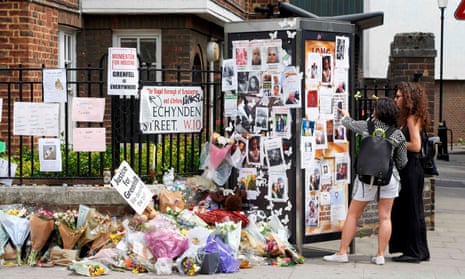In the fraught days after the Grenfell Tower fire in June, controversy over the official number of dead worsened already tense relations between officials and residents.
A day after the fire, the death toll released by the police stood at 17, and the next day it jumped to 30, at a time when a quick count of the photographs of the missing stuck to the walls and fences surrounding the building suggested the real number was much higher.
Among the crowds of traumatised residents waiting for news in local community centres and churches, there was anger that officials were apparently not being upfront about the real scale of the tragedy.
The Metropolitan police’s announcement on Thursday that the final death toll was 71 will largely quell lingering unease over the figures, but mistrust of officials is so potent among relatives of the dead and survivors that even now there remains residual scepticism.
Emma Dent Coad, the Kensington MP, said she hoped the announcement would end the uncertainty. “There were rumours circulating soon after the fire challenging early estimates of deceased and missing,” she said. “However, the police have done an incredibly thorough job – in addition to the difficult forensic work with fire service teams – of cross-referencing everyone reported missing.
“After five months, I have every confidence in this police statement.”
There were practical reasons why the police and fire services were unable to confirm the number of dead quickly. The day after the fire, the top of the building was still burning and the fire service was unable to reach the upper floors. Even when they were able to access the top, the heat had been so catastrophic that it was clear the identification of bodies would not be easy.
But in the absence of clear information, rumours about hundreds of victims quickly took hold. The media was criticised for its apparent willingness to downplay the numbers, as reporters repeated police figures. Groups of grieving survivors took to the internet to research and compile independent death tolls, coming up with much higher numbers. The singer Lily Allen said the death toll was being “suppressed” by the mainstream media and was likely to be more than 150.
The local Labour councillor Robert Atkinson said difficulties were intensified because the council did not appear to have clear lists of who was living in the block, amid concern over illegal subletting. “It is an indication of how much chaos and confusion there was in the aftermath that these rumours were allowed to spread like wildfire,” he said. “People started to try to count the dead themselves and numbers got double counted. It was absolutely shambolic.
“While I accept the police and coroner’s office had to be cautious because of the complexity of the site, it created a rumour mill. The tenant management organisation and the council are to be condemned because they didn’t know who was living in the block.”
Karim Mussilhy, whose uncle Hesham Raman died in the fire, said he remained sceptical. Given that 223 people were known – through analysis of CCTV footage – to have escaped the building, he questioned whether 293 was a plausible number of people to be have been in a block with 124 flats at the time of the fire.
“It just seems really low,” he said. “We still don’t know if there were people there who had immigration issues, whose relatives are too scared to come forward, or if there were people who had no family in the UK
“I don’t know if people will continue to question it.”
But he said most families were looking beyond the death toll, towards the bigger question of what caused the fire. Mussilhy, who has been named as an official participant in the public inquiry, said there was widespread exhaustion among survivors and relatives.
“We are grieving and we are sick of fighting with the police and council over the numbers,” he said. “Our anger and frustration with the police has died down a bit – we understand what a big job they have with this, and we want to work with them side by side.”
Dent Coad said her key concern now was the large numbers of residents of the tower and the surrounding blocks who were made homeless by the fire, and who remained in emergency accommodation.
“Let’s also remember the hundreds of survivors and evacuees still in bed and breakfast and temporary accommodation,” she said.
Figures released by Kensington and Chelsea council indicate there are 123 households from the tower and the walkway at the foot of the tower still living in emergency accommodation.
“We know that many are extremely stressed and their families are desperate and losing hope,” Dent Coad said. “The Christmas holidays are not far away. We must do everything humanly possible to get people moved into suitable permanent accommodation.”
